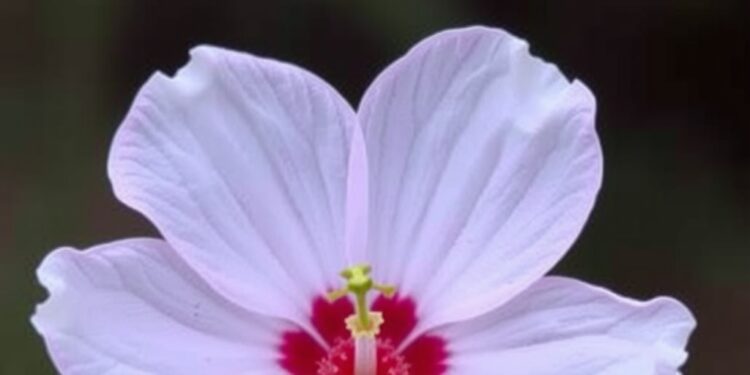
Unveiling the Mystery of Red Stigmas in Wind-Pollinated Trees: A Study on Hazelnuts and Their Adaptive Traits
The evolution of flowering plants has fascinated botanists and biologists alike, particularly those investigating the significant variations in reproductive strategies among species. One particularly intriguing case is that of the American hazelnut, which sprinkles the forest floors of Missouri with its delightful nuts each fall. While typically regarded for their gastronomic value, recent research has shed light on the fascinating reproductive biology of these trees, especially focusing on the unique characteristics of their female flowers.
In the stark landscape of a leafless forest, the American hazelnut’s female flowers exhibit an unusual and captivating appearance. Blooming in late February, they are adorned with protruding red stigmas that capture the attention of onlookers. These stigmas, clustered at the ends of short, woody branches, possess an almost theatrical elegance reminiscent of flaming red fingers raised to the sky or sparkling firework displays. This striking feature begs the question: what evolutionary advantage does this peculiar pigmentation provide?
While many flowering plants rely on colorful petals to attract pollinators, the hazelnut presents an exception. This species, alongside other wind-pollinated trees, does not require insects for reproduction as it relies solely on the wind to distribute pollen from male catkins to female stigmas. Thus, the energy expenditure towards producing such vivid red pigments appears superfluous at first glance. Dr. Susanne Renner, a biologist at Washington University in St. Louis, finds this paradox particularly compelling.
In collaboration with researchers from Beijing Normal University, Renner embarked on a thorough investigation into the floral characteristics of different species within the walnut family, specifically studying those exhibiting red versus green stigmas. This research revealed that red stigmas of certain plants accumulate anthocyanins—pigments also responsible for the brilliant colors found in autumn leaves. But why would wind-pollinated species need such pigments in the first place?
The study elucidated that these anthocyanins serve crucial antioxidant roles that significantly benefit the reproductive process. They act as an essential protective mechanism, scavenging reactive oxygen species which tend to accumulate and potentially cause sun damage to sensitive tissues. This photoprotection is especially vital for the exposed stigmas, which are crucial for successful pollination. The role of anthocyanins extends beyond mere aesthetic appeal; it is instrumental in enhancing reproductive success in harsh environmental conditions.
As the flowers bloom and grapple with sun exposure, the adaptation of red stigmas emerges as a fascinating evolutionary trait. Renner postulates that this characteristic may be particularly prominent in wind-pollinated species that feature large stigmas. While the mechanisms of pollination may differ from those reliant on animal vectors, these plants face their own set of challenges that can impede their reproductive efficacy. A structured strategy that incorporates antioxidant properties represents a sophisticated response to these pressures.
In the observed hybrid zones in China, where trees with prominent red stigmas flourish alongside others with more subdued green hues, a dynamic interplay of genetics becomes evident. The ability to cross-pollinate while exhibiting such distinct characteristics opens intriguing avenues for further research into the genetic mechanisms underlying these color variations. Resolving the genetic bases that dictate stigma coloration could yield critical insights into the evolutionary trajectories of these trees.
Most notably, the research highlights the environmental pressures that continually shape the adaptive traits of plant species. Conducting long-term observational studies within these hybrid zones can unveil more nuanced information regarding the adaptive advantages inherent in reproductive morphology. Each anatomical feature, from robust pollen tubes to resilient stigma papillae, plays a vital part in the overall success of the reproductive process in interconnected ecosystems.
Moreover, the implications of such findings reach far beyond the realm of basic science. Grasping how plants adapt to their environments can inform conservation strategies, particularly in the context of climate change and habitat fragmentation. Understanding plant reproductive biology, especially in wind-pollinated species, provides pivotal knowledge in mitigating biodiversity loss.
As scientists continue to unravel the complexities of flowering plants, the case of hazelnuts and their vivid red stigmas serves as a reminder of the intricate interconnections between flora and their ecosystems. The investigation of these seemingly trivial characteristics can provide profound insights into the evolutionary drivers shaping the natural world around us.
Through the lens of this study, we witness the grandeur of adaptation unfold, showcasing not only the beauty of plants but also the intricate web of life they participate in. Each discovery invites us to ponder deeper questions regarding resilience and survival in a world that is constantly fluctuating. The future of research on these fascinating wind-pollinated trees remains promising, poised to unlock further secrets that challenge our understanding of biology, evolution, and ecological interactions.
Subject of Research: The adaptive benefits of anthocyanin-red stigmas in wind-pollinated trees, specifically focusing on American hazelnuts.
Article Title: Genetic mechanisms and adaptive benefits of anthocyanin-red stigmas in a wind-pollinated tree.
News Publication Date: 10-Feb-2025.
Web References: Molecular Biology and Evolution
References: Available upon request.
Image Credits: Not provided.
Keywords: Wind-pollination, Hazelnuts, Anthocyanins, Plant adaptation, Stigma morphology, Evolutionary biology, Genetic mechanisms, Antioxidants, Plant ecology, Pollen dynamics, Reactive oxygen species, Plant reproduction.
Tags: adaptations of American hazelnutbotany of wind-pollinated speciescharacteristics of hazelnut treesevolutionary advantages of hazelnutsflowering plants without pollinatorsimpact of environmental factors on floweringred stigmas in wind-pollinated flowersreproductive biology of flowering plantsrole of color in plant reproductionsignificance of female flowers in treesstudy of plant reproductive strategiesunusual features of tree reproduction





